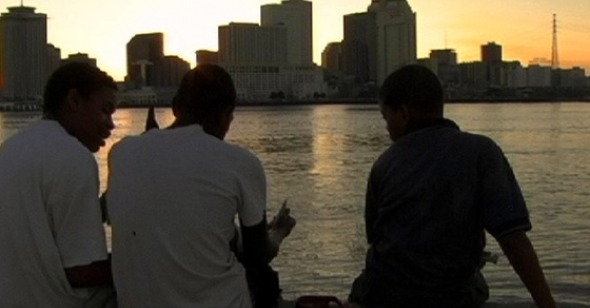Night in the City
by Jeff Reichert
Tchoupitoulas
Dir. Bill and Turner Ross, U.S., Oscilloscope Laboratories
In the latest documentary from Western Ohio’s young Bill and Turner Ross, Tchoupitoulas, named after a street in the Big Easy, three young, African-American protagonists scamper through the city over the course of one long evening. The film, coming as it does after their lauded 45365, suggests the brothers are putting out some of our most exciting nonfiction filmmaking. Unlike many of those working in more mainstream American documentary, the Ross brothers are not out to change the world or introduce viewers to fascinating alternate histories of major figures or events, and the only band it showcases is anonymous New Orleans brass. The film merely tracks brothers William, Bryan, and Kentrell Zanders as they leave their home one night, take the Algiers ferry to the French Quarter, and have an adventure on the titular avenue (which is home to Emeril Lagasse’s flagship restaurant, incidentally).
The filmmaking model for Tchoupitoulas is not Errol Morris or Werner Herzog or Ross McElwee. Rather, the Ross brothers seem to be channeling Morris Engel’s independently produced 1953 film Little Fugitive and Kent MacKenzie’s 1961 The Exiles, both of which used thin narratives and casts of nonactors to give viewers tours of visually striking environments—in the former, Coney Island, the latter Los Angeles’s Bunker Hill neighborhood. Like those films, Tchoupitoulas has a rangy, loose-limbed energy, but it’s less a “narrative” than either, and relies simply on the natural forward momentum of the three young boys to carry their viewers through an immersive sensorial catalogue of evening delights in New Orleans, including fire breathers, burlesque dancers, the aforementioned musicians, and more. We go where they go, see whatever catches their fancy.
The boys seem alternately bewildered, excited, and overwhelmed by the sights around them, and the Ross brothers’ handheld, but never annoyingly jumpy, camerawork, mirrors their exuberance. Like their easily distractible subjects, the filmmakers let their eyes wander—for example the camera will hang on the backs of the boys’ T-shirts as they dance down the street, only to drift off and watch a performance before picking out the film’s heroes further down the block. The effect is a gentle, curious omniscience that relies on the central trio to pull it through space but which still maintains enough of its own agency to float into fascinating places the boys could never enter on their own. It’s a quite unique camera/subject relationship for contemporary documentary, and it feels as though all five of the film’s main participants (both groups of brothers) are equally complicit in the making of Tchoupitoulas.
As concerned as the film is with sound and visual sensation, it isn’t entirely narrative-free. Late in the film, the boys rush to catch the last ferry, only to miss the closing gates by seconds, a sequence that introduces a welcome element of tension: how will they get home? The filmmakers don’t provide any support in this regard; if this was a truly dire situation the Rosses could clearly have just given the boys a ride, and our knowing this subtly signals the blur the filmmakers have created between fiction/nonfiction and subject/filmmaker. When the kids trespass onto a decrepit, abandoned river barge scattered with broken furniture and chandelier remnants (the Ross brothers here find their most baroque interiors, and their camerawork appropriately slows down to take it all in), the danger surrounding them is palpable, leaving us to wonder if they will make it out unscathed. The tension of the sequence is a capstone in the film’s anything-can-and-might-happen mentality. (In a post-screening Q&A, Bill Ross admitted that he and his brother questioned whether or not they should allow the boys onboard or just observe—the conundrum of documentary filmmaking.)
Instead of falling into the shallow-focus DSLR camera rut, the Rosses shoot on lovely degraded video, lending their nighttime images a ghostly, grainy quality. Shot over nine months and smartly condensed into its single-night conceit, Tchoupitoulas will certainly raise questions from that subset of documentary viewers who look for story and character above all; the only moments of subjectivity can be found in brief, dreamy snatches of voiceover from youngest brother William talking about his dreams at the head and tail of the film. But the film’s aims are purer than any more typically character-driven affair: the Ross brothers seek to document an experience, happening in a specific place and moment, and get as close as one can imagine to seeing it through the eyes of their protagonists. (Imagine a less forbidding and austere version of Véréna Paravel and Lucien Castaing-Taylor’s lauded, experimental fishing-expedition movie Leviathan.) Tchoupitoulas is as admirably old-fashioned as the New Orleans entertainments and neighborhoods it films so lovingly—paradoxically this makes it one of the most forward-looking documentaries of the year.
